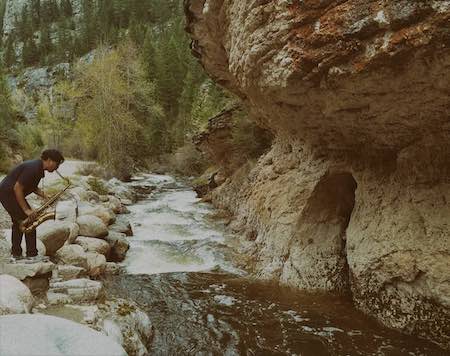Jun 3, 2025 11:25 AM
In Memoriam: Al Foster, 1943–2025
Al Foster, a drummer regarded for his fluency across the bebop, post-bop and funk/fusion lineages of jazz, died May 28…

Jon Irabagon plays in the Falling Rock Canyon of South Dakota.
(Photo: Talia Irabagon)In the pantheon of performers on unaccompanied saxophone, Jon Irabagon has a powerful claim to membership — one based on recorded solo turns on sopranino for 2015’s Inaction Is An Action and mezzo soprano for 2019’s Invisible Horizon (both on his own Irabbagast Records) as well as live sets at more than half a dozen New York venues.
Irabagon, now 42, is adding to that body of work with two solo-tenor projects: an album recorded in the wild and a documentary produced in a black-box performance space. Together, the projects — Bird With Streams and Legacy, respectively — contribute to a kaleidoscopic picture of an acclaimed improviser working in the riskier reaches of his craft.
On the surface, the projects seem to share little apart from Irabagon’s solo saxophone. The album, which landed in July, is a low-fi exercise recorded by Irabagon who, upon decamping to South Dakota during the pandemic’s 2020 peak, grabbed a microphone, a pad, his tenor and little else before embarking on what became eight months of daily exploration in Falling Rock, a canyon amid the Black Hills.
By contrast, the documentary, streaming in October, is a high-gloss affair. Filmed over four, 15-hour days in April — six months after Irabagon left the canyon — it finds him operating under controlled conditions in Ohio’s Columbus Dance Theater, surrounded by lighting experts, sound designers and make-up stylists.
The projects draw on different material. The album, on Irabbagast, features the music of Charlie Parker. The film, produced by the nonprofit A Tribe for Jazz, features Irabagon’s tunes.
The approaches also differ. “In the Black Hills,” Irabagon explained in an August Zoom call, “it was about my being as expansive as possible: turning every stone over, thinking of every possibility and trying to get there through my horn. The Legacy project was more about a distillation — from the Black Hills to the black box to the black hole — being as compact as possible, just trying to get to the essence of each tune.”
Ultimately, he added, “the projects are the flip side of the same coin. They both boil down to me trying to be as expressive as possible on the solo instrument.”
On Bird With Streams, he delivers some wicked bebop-inflected blowing on tunes like “Sippin’ At Bells.” Elsewhere, he mines his considerable bag of technical tricks: flutter-tonguing with key slaps on “Mohawk,” buzzing like a trumpeter into his mouthpiece on “Anthropology,” sucking air through his horn on “Moose The Mooche” (an attempt, to mimic the windstorms in the canyon).
In real time, he plays with and against the canyon’s ambient sounds. But he was not averse to advancing a narrative in post-production. On the closer, “Quasimodo,” his final vamp fades in a rush of water taken from a sound sample. The intent, he said with a smile, was to evoke a legendary flash flood from a purportedly haunted creek in the canyon — a bit of offbeat humor, perhaps, but that fits Irabagon’s aesthetic.
Legacy, at 40 minutes in length, presents deeply felt re-imaginings of tunes from past albums, opening with a doleful “Dark Horizon.” Bathed in misty-colored light, a wide-brimmed hat casting a shadow on his eyes, Irabagon ratchets down what was a high-flying interpretation of the piece on Invisible Horizon in the pre-pandemic year. In the end, he said, he lands in a “more somber, focused, quieter place.”
“The Music Box Song (For When We’re Apart)” presents Irabagon in a similarly restrained light. Written as a gift for his wife, the tune was first recorded by his quartet on 2015’s Behind The Sky. “With the quartet, it gets to a certain place,” he said. “But the tune is so delicate and melancholy that I felt like it would be perfect for a solo tenor saxophone setting.”
Whatever the mood, Irabagon largely avoids the grand gesture. But the interpretations all have an urgency to them, none moreso than the film’s closer, a new original, “Alliance.” It unites the two tenor projects — bringing the capaciousness of the outdoor experience into the black-box environment in a sweeping but succinct statement hinting at fusion grooves, a samba beat and a mystic ’60s vibe. The statement will be fleshed out in a quartet version next year.
“I want to expand my direction in every way,” he said. DB

Foster was truly a drummer to the stars, including Miles Davis, Sonny Rollins and Joe Henderson.
Jun 3, 2025 11:25 AM
Al Foster, a drummer regarded for his fluency across the bebop, post-bop and funk/fusion lineages of jazz, died May 28…

“Branford’s playing has steadily improved,” says younger brother Wynton Marsalis. “He’s just gotten more and more serious.”
May 20, 2025 11:58 AM
Branford Marsalis was on the road again. Coffee cup in hand, the saxophonist — sporting a gray hoodie and a look of…

“What did I want more of when I was this age?” Sasha Berliner asks when she’s in her teaching mode.
May 13, 2025 12:39 PM
Part of the jazz vibraphone conversation since her late teens, Sasha Berliner has long come across as a fully formed…

Roscoe Mitchell will receive a Lifetime Achievement award at this year’s Vision Festival.
May 27, 2025 6:21 PM
Arts for Art has announced the full lineup for the 2025 Vision Festival, which will run June 2–7 at Roulette…

Benny Benack III and his quartet took the Midwest Jazz Collective’s route for a test run this spring.
Jun 3, 2025 10:31 AM
The time and labor required to tour is, for many musicians, daunting at best and prohibitive at worst. It’s hardly…